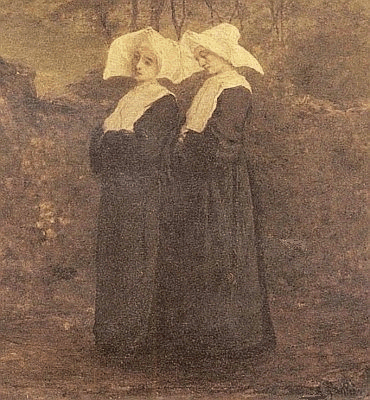
Cornette
Encyclopedia

Wimple
A wimple is a garment worn around the neck and chin, and which usually covers the head. Its use developed among women in early medieval Europe . At many stages of medieval culture it was unseemly for a married woman to show her hair...
consisting of a large starched piece of white cloth that is folded upwards in such a way as to create the resemblance of horns on the wearer's head.
Cornettes folded in different fashions (more upwards or more towards the head) were originally worn by married women of the urban middle class. They continually fell into disuse during the 17th century.
Use by the Daughters of Charity
The cornette was retained however as a distinctive piece of clothing into modern times by the Roman CatholicRoman Catholic Church
The Catholic Church, also known as the Roman Catholic Church, is the world's largest Christian church, with over a billion members. Led by the Pope, it defines its mission as spreading the gospel of Jesus Christ, administering the sacraments and exercising charity...
religious order
Religious order
A religious order is a lineage of communities and organizations of people who live in some way set apart from society in accordance with their specific religious devotion, usually characterized by the principles of its founder's religious practice. The order is composed of initiates and, in some...
of the Daughters of Charity, founded by St. Vincent de Paul
Vincent de Paul
Vincent de Paul was a priest of the Catholic Church who became dedicated to serving the poor. He is venerated as a saint in the Catholic Church and the Anglican Communion. He was canonized in 1737....
. The founder wanted to have the sisters of this new type of religious congregation of women, that tended to the sick poor and were not required to remain in their cloister, resemble ordinary middle-class women as much as possible in their clothing - this was the reason why the cornette was adopted.
After the cornette generally fell into disuse, it became a distinctive feature of the Daughters of Charity, making them one of the most widely recognized religious orders by their habit. This religious order was known in Ireland by their cornette as the Butterfly nuns. The wearing of the cornette was abandoned by the order on September 20, 1964.
The cornette in popular culture
- The headgear of the nuns in the American 1960s TV series The Flying NunThe Flying NunThe Flying Nun is an American sitcom produced by Screen Gems for ABC based on the 1965 book The Fifteenth Pelican, by Tere Rios, which starred Sally Field as Sister Bertrille...
was meant to be a reference to (and spoof of) the cornette. It is the driving force of the plot in the series, as the main character (played by Sally FieldSally FieldSally Margaret Field is an American actress, singer, producer, director, and screenwriter. In each decade of her career, she has been known for major roles in American TV/film culture, including: in the 1960s, for Gidget or Sister Bertrille on The Flying Nun ; in the 1970s, for Sybil , Smokey and...
) is so lightweight that she is taken up by every gust of wind because of the cornette she is wearing, and is thus able to fly. - In the 2006 Doctor WhoDoctor WhoDoctor Who is a British science fiction television programme produced by the BBC. The programme depicts the adventures of a time-travelling humanoid alien known as the Doctor who explores the universe in a sentient time machine called the TARDIS that flies through time and space, whose exterior...
episode, New Earth, the humanoid cat people of the Sisters of Plenitude wear a cornette with their gowns. - The cornettes worn by the St. Vincent nuns were a popular inspiration for painter Robert VickreyRobert VickreyRobert Remsen Vickrey was a Massachusetts-based artist and author who specialized in the ancient medium of egg tempera...
.

